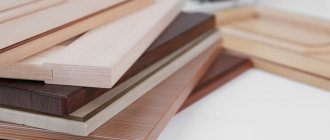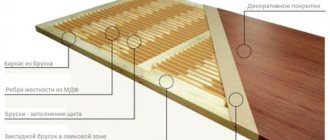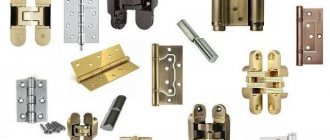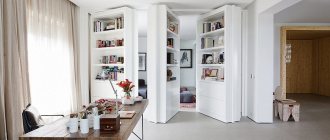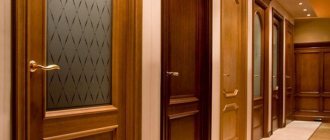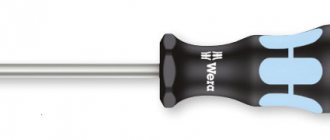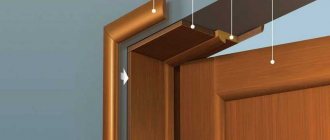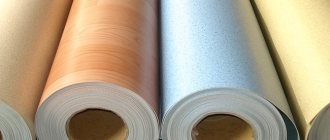Veneer
Veneer is a thin layer of natural wood coated with varnish. The method of its production allows you to preserve the structure of real wood, get rid of the shortcomings of the solid wood and slightly reduce the cost of the final product. According to production technology, veneer can be divided into three types:
- Sliced natural veneer. The most durable - thick plates protect the canvas from damage.
- Fine-Line. This is reconstituted veneer - a thin section of softwood that has been pressed, painted and varnished. It is not very durable, but it is inexpensive.
- Multispon. These are painted wood chips that imitate the texture of wood. It is glued together with melamine resins and then varnished. It is a porous material and should be used with caution in damp areas.
Good veneer can be as expensive as solid wood. The most expensive categories include oak or ash veneer. Aspen, maple and poplar will cost a little less. Fine Line and multi-veneer are the most budget options.
Pros:
- The structure of natural wood is preserved.
- Interior doors made of veneer are easy to restore - just update the varnish.
Minuses:
- Low sound insulation and moisture resistance.
Eco-veneer
Eco-veneer is a polymer film that imitates natural veneer. Its main advantage is the price. Compared to natural analogues, such canvases are two to three times cheaper.
Pros:
- Doors made of eco-veneer can be more durable: the coating is applied without an edge - that is, the door is sealed, as it were, which means that moisture and dirt cannot penetrate inside the panel.
Minuses:
- Inexpensive options do not look like real wood.
- It is difficult to restore damage, because if there are chips or scratches of more than two millimeters, the entire coating will have to be replaced.
PVC
Polyvinyl chloride, or PVC, is an elastic film that can be given any color and texture. For example, wood, leather and even silk. The film can be matte or glossy.
PVC is glued under pressure to the array or to individual parts, such as drawers. Such doors are slightly more expensive than laminated ones, but cheaper than veneered ones.
Pros:
- Large selection of colors and designs.
- Moisture resistance.
- Affordable price.
Minuses:
- The coating cannot be repaired - in case of minor damage, you can spot-cover small scratches and glue the film. But for large cracks and chips, the entire canvas will need to be replaced.
- Low sound insulation.
- Fear of moisture. If the film is not glued as a single piece, then in damp rooms it can peel off from the canvas at the corners.
MDF
MDF is compressed and glued sawdust that is painted and covered with veneer or film. For the internal filling of such doors, corrugated cardboard or shield is used.
Pros:
- MDF doors are relatively inexpensive, but they withstand changes in temperature and dampness well. They can be installed in rooms even with a humidity level of 80%.
Minuses:
- Poor sound insulation.
Chipboard
Chipboard is also made from sawdust, only larger ones. They are mixed with an adhesive and then pressed. And it is the type of composition that determines how moisture-resistant the resulting fabric will be.
Maxim Kotyrev door installation master
4,88 123
Open profile
Chipboard is a natural material, but with an adhesive base. Therefore, you need to look at what this basis is. The manufacturer can use acrylic or alkyd compounds. The former repel moisture, the latter allow moisture to pass through.
When making doors from chipboard, a minimum amount of solid wood is used. As a rule, the block is placed only at the edges of the canvas, and the internal space is filled with cardboard honeycombs. The door itself is laminated or covered on the outside with PVC film.
Pros:
- If the correct adhesive composition is used - acrylic, then the doors are quite moisture resistant.
Minuses:
- Dents on the canvas cannot be straightened out, so the door cannot be repaired.
- The canvas is fragile and allows sound to pass through.
Glass
This option is best suited if you want to visually enlarge the space and add more “air” to the room.
The first thing you should pay attention to when choosing is durability. Triplex made of tempered glass is considered the most reliable - if damaged, it does not crumble into small fragments and does not collapse entirely.
Then you can think about the design. Glass can be frosted, with 3D prints and designs, or sandblasted.
Pros:
- The glass door is not afraid of either high humidity or temperature changes.
Minuses:
- It is difficult to keep light and sound out of such a door.
- If there are small children or animals in the house, you should be wary of this choice - after all, glass is a much more fragile material than wood.
Methods for opening interior doors
In addition to classic swing doors, there are sliding, accordion and pendulum doors. Doors with non-standard opening mechanisms are more expensive, but they save space and look more original.
Swing doors
Traditional swing interior doors are the most common. They come in single-leaf types for regular openings and double-leaf ones for wide ones. You will find such doors in any salon.
Pros:
- Price and availability: you can choose an option for any budget.
- They can be placed anywhere - at the end of the room or in the corner.
Minuses:
- A swing door takes up more space than, for example, a sliding door. It will be necessary to free up space not only in front of the doorway, but also on the side of it.
Pendulum doors
These are also swing doors, but they open in both directions: inward and outward. They can often be seen in the subway or cafes.
This option does not require installing a door frame - and this is both a plus and a minus.
Pros:
- You can save on additions and platbands.
Minuses:
- Sound insulation will be low. In addition, you will have to free up space on both sides of the door.
Sliding doors
Such structures are divided into single-leaf and double-leaf - according to the number of panels.
Their main advantage is that they do not “eat up” the space in front of the doorway. And if you assemble a special box and build it inside the wall, then additional space will appear on the sides of the door.
Options for sliding interior doors:
- Sliding, like in a wardrobe. These also include barn doors, which ride on a track mounted above the doorway.
- Cassette - retracted into a niche built into the wall.
Pros:
- Sliding doors can be installed as partitions. The option with transparent or translucent doors is often used for zoning in elongated rooms with a window at the end. For example, to divide them into a bedroom and a living room without losing some of the natural light.
Minuses:
- Fragility.
- Poor insulation of sound, smell and light.
- Noise when opening and closing.
- High price.
Accordion doors
Externally, these sliding doors are similar to regular swing doors. The difference is that the canvas is folded into two or three folds and moved to one of the jambs.
Pros:
- Folding interior accordion doors can be installed in small rooms that open onto a narrow corridor. For example, storage rooms or bathrooms.
Minuses:
- Accordion doors can be expensive. The more complex the mechanism, the higher the likelihood of failure. Therefore, if you decide to save space, don’t save money - choose a reliable manufacturer and check several times before purchasing that the door moves smoothly along the rail, does not jam or wobble from side to side.
Walk-through kitchen
A walk-through kitchen presents fewer problems than a living room, but nevertheless makes you think about the layout and choice of furniture, especially for a small room. Although the most convenient option for the living room, when the doors are located opposite each other, is completely unsuitable for the workspace - here the passage itself is a place for the housewife to move while cooking. Accordingly, additional free spaces actually take away functional area.
To improve the ergonomics and functionality of the kitchen, you can use different techniques:
- An example of a walk-through kitchen would be a space with access to a balcony. Here on the aisle there is often a dining group with chairs, but not a sofa.
- A kitchen passage without a window can also become part of the set: here you can hang wall cabinets or open shelves for utensils.
- A parallel set will help free up space near the window opening for a dining area and even a kitchen corner.
An important nuance in this case is the content of the interior and its style. Overly detailed and decorated furnishings will require a lot of space - for decoration, from furniture to objects on shelves. Therefore, laconic interior designs with simple solutions are chosen for the workspace, especially for a walk-through kitchen.
How to choose the color of an interior door
Doors should fit harmoniously into the interior. Here's what the designers advise:
- Light colors visually enlarge the space. Therefore, in small rooms it is better to install white doors or light wood doors.
- Shades of black and brown, on the contrary, visually narrow the space. Therefore, it is better not to install dark doors, for example wenge colors, in narrow and dark rooms. The ideal place for them is spacious rooms with low ceilings.
- If all rooms have the same floor, then you can choose the same doors.
- You can match solid wood furniture with doors of the same shade.
- Doors can be painted different colors on different sides - but only if they are closed most of the time. For example, one side of the canvas is painted to match the color of the bedroom, and the other matches the hallway.
- It is better to choose the same color and material for platbands and skirting boards.
If you don't find doors that match your color, you can paint them yourself. There are special canvases that are called “paintable”. They are already primed, all that remains is to apply a layer of furniture paint. If you tint them to match the color of the walls, you will get “invisible” doors.
Introduction of paintings from different materials into the interior
Wooden
Solid wood entrance openings are expensive because they are made from oak, teak, hornbeam, walnut, and ash wood. Exotic fabrics are obtained from ebony, red, black trees, Karelian birches, rosewoods.
They are always used in classic, baroque style with decorative carved inserts. They can also be used in modern designs, but the surface must be perfectly flat and painted in a single color.
Veneered
Veneering is used to refine non-valuable tree species and chipboard. A beautiful effect is obtained after covering the panels with veneer, sanding and varnishing. This method is environmentally friendly because wood glue and natural materials are used. However, such a door cannot be installed in rooms with high humidity, because the base may swell and the veneer may peel off.
Veneered structures are suitable for the same designs as solid wood: classic, modern, baroque, art deco. Moreover, they will look like solid solid doors.
Plastic
Plastic doors are made from polymer materials. Panels of polyvinyl chloride are glued to the pine board base. Then, under a press, it is securely fixed and a different texture is made. The result is a waterproof, durable, heat-preserving and sound-insulating panel.
Due to the imitation of wooden texture, it can be introduced into modern classics, modern, and art deco. But it is more often used in minimalism, hi-tech, loft.
Laminated
Lamination is similar to pasting with polymer materials, but instead of pine, MDF or chipboard is pasted over. The result is a not very expensive design with protection from moisture. Laminated doors are being introduced into loft, minimalism, hi-tech, etc. styles. Due to the variety of PVC film, it can be integrated into any design.
From glass
Glass panels are made from tempered glass. They expand the space, add freshness to the atmosphere and almost erase room boundaries. Clear glasses with small patterns and designs are popular now because they suit minimalism. But you can order glass of any palette and be original.
Don't miss: Interior door trims. Types of decorative overlays for entrance doors
How to choose an interior door by size
Door leaves have standard width dimensions:
- 600 mm - in the toilet and bathroom;
- 700 mm - in the kitchen;
- 800 mm - in the bedroom, living room, hall.
The height of standard interior doors is 2000 mm.
The size of the doorway depends on the size of the door. It should be wider enough so that in addition to the canvas, a door frame can also fit into it.
If you want to make an opening of a non-standard size, be prepared that the doors will have to be made to order. The main thing here is not to miss the size. And the easiest way to do this is to invite a measurer. And the point is not that without a specialist you will have to operate the tape measure and level yourself. The master will simply not only correctly calculate the length and height, but also advise you on which doors are best to choose for a specific room and budget.
Photo ideas
Look at the dark and light doors in the interior of the apartment, real photos:
Post Views: 10,089
How to choose a door set
The door set consists of five elements:
- door leaf,
- door frame,
- extras,
- platbands,
- accessories.
The door frame is what the door leaf is attached to. Its standard width is 7 cm. Since the walls in apartments are usually wider, an extension has to be mounted to the frame - a strip that serves as an intermediate link between the frame and the platbands.
The purpose of the platbands is to cover the junction of the extensions with the wall. The average width of the platband is from 60 to 100 mm.
Now manufacturers offer simpler solutions. For example, doors are installed directly on the frames and frames, and the door frame is not used at all. Another life hack is telescopic or sliding trims that are attached directly to the box.
Interior door hardware consists of hinges and handles. In rare cases, locks and closers are added to them.
Loops
There are three main types of hinges for interior doors:
- overhead butterfly loops,
- card loops,
- hidden loops.
Standard butterfly hinges are easy and cheap to install, but within a year they can sag and the fittings will have to be replaced. Therefore, craftsmen suggest giving preference to card or hidden hinges - yes, they are expensive, but beautiful and reliable.
Maxim Kotyrev door installation master
4,88 123
Open profile
I often come across the fact that customers purchase quite expensive doors and try to save on fittings - install butterfly hinges. In fact, they are intended for office and technical doors. Now they have begun to produce reinforced butterfly hinges, but they are still far from the class and level that a mortise or card hinge has. Therefore, during installation, the customer has to be warned that these “budget” hinges will need to be changed at least once a year.
Hinges are made from steel, brass, zinc and steel alloys. For heavy panel doors, experts recommend using powerful steel or brass hinges. Fittings made of zinc and steel alloys are better suited for relatively lightweight PVC sheets filled with corrugated cardboard.
Pens
Pens come in four main types, each with their own pros and cons.
| Handle type | pros | Minuses |
| Stationary | Withstands heavy loads. They don't spill the beans. They're cheap. | Latches are missing. |
| Handles on the socket | You can install a latch and lock. Does not require force when opening. | More expensive than stationary ones. |
| Handles on the bar | There is a lock and latch. Reliable design. | They take up a lot of space on the canvas. Difficult to install. |
| Knobs | There is a latch. Inexpensive. | They take up a lot of space on the canvas. Short-lived. |
Handles are made from brass, aluminum, zinc-aluminum alloy, stainless steel and plastic. Brass is the most expensive, but also the most durable. Aluminum ones are budget-friendly, but are designed for not very heavy doors. Handles made of inexpensive zinc-aluminum alloy, or TsAM, are the optimal solution for bathrooms, because they are not afraid of moisture. The stainless steel and plastic options are quite flimsy - this is not the best solution for such a frequently used interior detail.
Experts advise not to skimp on fittings - as a result, replacing them may cost more. In addition, by changing failed hinges and broken handles, you will violate the integrity of the canvas every time. The safety margin of any material is limited, and even the highest quality doors with poor fittings will last less.
Tricks for selecting and combining tone
Often different room designs need to be framed with a suitable structure. Some owners purchase openings for the entire house that match the color of the entrance, but this is not always appropriate. For a more successful design, there are other ways.
You can use skirting boards and trim that match the doors. If the rooms have nothing in common, then you can install a neutral half-tone entrance structure, a volumetric baseboard and platband over the entire area and you will get a unifying line.
An expensive but effective way is to veneer different sides in a suitable color scheme for adjacent rooms. This is done only to order, the result is good.
Decorative wall stickers can transform a structure beyond recognition. They look like photo wallpapers and also cover the surface. By gluing various images of nature, city streets, lush buds, and abstractions, you can make a picture.
For some houses, contrasting bright designs can be installed. But this can be annoying, so discuss bright decorations with all residents.
Checklist for purchasing interior doors
Evgeniy Shcherbakov, a door installation master, shared advice on how to choose the right interior doors:
- Check the door geometry. Take a tape measure and measure the fabric at the bottom, middle and top. A difference of even 5 mm indicates a low quality product.
- Check the blade for a “propeller”: inspect the door from above and from the side, check if the blade is bent in different directions.
- Check the door's rigidity. To do this, take the door in your hands and try to squeeze or bend it. Not a single part should move from side to side, wobble or creak.
- Check the coating for defects. The veneer should not come away from the MDF, and the film should not peel off.
Updating the input structure
The simplest and most affordable way to update a door is to cover it with fresh paint, since the old layer spoils the aesthetic appearance and changes color over the years. Initially, you need to decide what the structure will be covered with:
- stain, tinting varnish;
- thick enamel, acrylic, polyurethane oil paint.
When choosing a coating, we base it on individual preferences, but it is worth listening to the advice of experienced craftsmen - finishers.
Additional qualities
Depending on where the door is planned to be installed, the following qualities may be required from it:
- In the living room. The entrance to the living room demonstrates the style and taste of the owners, so aesthetic requirements are important. Functionality is no less important: doors should not block the passage, and in the open position they should not obscure interior items.
Timeless classic Source aviarydecor.com
- In the bedroom. The emphasis is on light and sound insulation. It’s good if there is an opportunity for privacy, for which the structure is equipped with a lock.
- In the kitchen. Moisture resistance and the ability to isolate odors come first. It is also important that the surface can withstand frequent wet cleaning.
- In the bathroom and toilet. The moisture resistance of the fabric is important here; You can't do without a lock or latch.
- In the nursery. The door leaf will require anti-vandal protection, as well as good sound insulation and safe operation.
- In the office. In addition to a solid appearance, sound insulation and the ability to lock the door from the inside and outside are important.
Creating the effect
Do you like creative chaos and are you ready for a bold experiment? Give your interior a color shake-up using doors. Draw on the doors with markers, spray them with paints, leave handprints on top - your door will turn into a real art object.
Photo:
A colored door can be decorated in an original way using photographs. These can be your photographs or colorful photo wallpapers. This option is perfect for sliding doors that divide space.
Photo:
